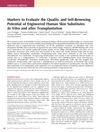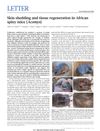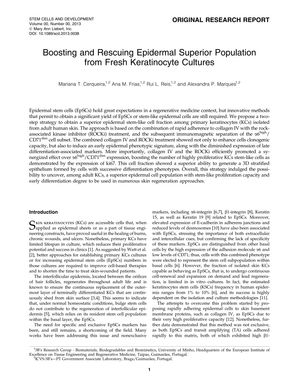TLDR The method increases stem-like cells for better skin regeneration.
The study from 2014 investigated a method to increase the yield of stem-like cells from primary human keratinocytes. The researchers used a two-step strategy involving rapid adherence to collagen IV and treatment with a ROCK inhibitor, followed by immunomagnetic separation to isolate a specific cell subset (α6high/CD71dim). This approach resulted in an increased number of cells with clonogenic capacity and an early epidermal phenotype, while reducing late differentiation markers. The combined treatment of collagen IV and ROCKi was particularly effective in enriching for stem-like cells that could form organized 3D stratified epithelia. The study concluded that this method could be beneficial for skin regeneration applications. At least four independent samples were analyzed, as indicated by the data presentation. Financial support was acknowledged from Skingineering and the Portuguese Foundation for Science and Technology, with no competing financial interests reported.
 120 citations
,
August 2008 in “The journal of investigative dermatology/Journal of investigative dermatology”
120 citations
,
August 2008 in “The journal of investigative dermatology/Journal of investigative dermatology” Cytokeratin 19 and cytokeratin 15 are key markers for monitoring the quality and self-renewing potential of engineered skin.
 788 citations
,
February 2007 in “Nature”
788 citations
,
February 2007 in “Nature” The document concludes that skin stem cells are important for hair growth and wound healing, and could be used in regenerative medicine.
441 citations
,
May 1996 in “Journal of Cell Science” Keratin 19 helps identify skin stem cells, with its presence varying by body location, age, and culture stage.
 10 citations
,
September 2022 in “Advanced Healthcare Materials”
10 citations
,
September 2022 in “Advanced Healthcare Materials” Current methods can't fully recreate skin and its features, and more research is needed for clinical use.
16 citations
,
March 2021 in “Frontiers in cell and developmental biology” A new method using Y-27632 improves the growth and quality of human hair follicle stem cells for tissue engineering and therapy.
 January 2024 in “ACS Biomaterials Science & Engineering”
January 2024 in “ACS Biomaterials Science & Engineering” A new method using a microfluidic device can prepare hair follicle germs efficiently for potential use in hair loss treatments.
 1 citations
,
February 2023 in “ACS Biomaterials Science & Engineering”
1 citations
,
February 2023 in “ACS Biomaterials Science & Engineering” The new microwell device helps grow more hair stem cells that can regenerate hair.
 418 citations
,
September 2012 in “Nature”
418 citations
,
September 2012 in “Nature” African spiny mice can regenerate skin, hair, and cartilage, but not muscle, and their unique abilities could be useful for regenerative medicine.






